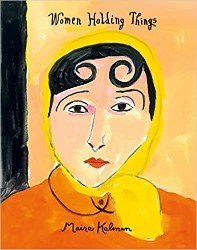Apple pie and cheddar cheese, pineapple and pizza, mango and chili powder. Gertrude Stein and Maira Kalman. An unexpected pairing, yet one that enhances the artistic offerings of both. Gertrude Stein’s works — while often dense and expansive — reveal a world of artists, writers, composers, and architects whose intersecting lives and friendships could easily belong in fiction. The surreal troupe introduced in this unconventional memoir is no exception, and their rich tapestry of relationships is brought to life through Kalman’s characteristically whimsical illustrations.
As the title suggests, the text is presented as an autobiographical work of Alice B. Toklas, Stein’s life companion. However, one does not have to delve deep into this book before it becomes apparent that it is actually Stein’s own work. Kalman artfully emphasizes this in the book’s endsheets, where she includes photographs of pages from an earlier printing of the manuscript; Kalman has underlined “Gertrude Stein,” which unwaveringly appears in every few lines of text.
While the narrative provides a vivid sense of Stein’s (and Toklas’s) world, it also includes voluminous insights into the greater Parisian literati and culturati of the 1910s, 20s and 30s. The book reads like Toklas’s diary, giving the reader details of the pomp and circumstance of the vernissage, as well as gossipy particulars about the monumental figures of the day (such as Picasso, Matisse, and Aldrich).
Kalman’s own playful personality also shines through in this edition even apart from her quirky illustrations. The reader can marvel in the illustrator’s afterword — a special “insider’s” postmortem where Kalman confides that she is “loath to leave them,” demonstrating the close bond that she developed with the couple during the course of her work. This bond is further reinforced in Kalman’s own literary pieces in the afterword, in which she explores her feeling of kinship with Stein based on their shared unconventional views on punctuation (or lack thereof) and informal, intimate prose.
For all the details of the relationships of Stein’s contemporaries, an exploration of Stein’s own identity is curiously absent from the book. While Stein and Toklas’s relationships is always superficially present, the intimacy between these two key characters is never developed or analyzed. And while the lack of detail on this aspect of Stein’s life may be a product of the time of the original text, this absence is felt. A similar absence is felt because Stein does not directly address her and Toklas’s Jewish heritage. However, one of the final chapters of the book — dedicated entirely to “The War” (World War I), leaves the reader with a haunted sense of what will be brought to fruition in Europe a decade later. Kalman also does not address this. Perhaps her omission is more deliberate: perhaps Kalman wants the reader to remain and revel in this pre-marred world marked by a modern cultural renaissance.




